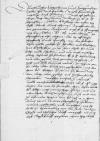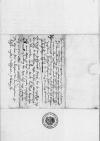Dem durchlauchten, hochgebornen fursten und hern, hern ⌊Albrechten⌋, / von Gots gnaden marggraff zu ⌊Brandenburg⌋, / in ⌊Prewssen⌋, zu ⌊Stetin⌋, ⌊Pomern⌋, der ⌊Cassuben⌋ und ⌊Wenden⌋ hertzogk, / burgraff zu ⌊Normberg⌋ und furst zu ⌊Rugen⌋, / unserm hochgunstigenn, lÿben hern und freundt
Unss ÿst jestrigs thags noch der sonnen undergang Ewer Furstlichen Durchlaucht ⌊⌋, / datum ⌊Kunsberg⌋, den ersten tag dÿss monds durch eynnen lawffenden boten geworden, / dorÿnnenn unss Ewer Furstliche Durchlaucht antzeigt, / wÿ der selbten ⌊konigliche maiestet⌋, unser allergnedigster her, schrÿfftlich befel gethann, / das dÿ uff negste ⌊thagfarth⌋ sandt Stanislai / von den ferlichen dÿser tzeÿtte geloffte zu handlen und ratslohen / ÿre botschaffter an dÿ hern ⌊dÿser koniglichen lande rethe⌋ wolte schicken, / und aus wass ursachen solchs dÿsmal zu furdren Ewer Furstlichen Durchlaucht beswerlich, / wer aber gesint noch gemelter thagfarth, / so tzeÿt und stelle benumpt wurd, / in eÿgner person ader aber durch ÿre geschicktenn / mit den hern koniglichen rethen zu samne zu komen, / wÿ dan solchs wol gesetzt und hochvorstendig schreÿben weÿther einhelt etc. Hiruff wolle wir freuntdinstlicher weÿs Ewer Furstlichen Durchlaucht nicht bergen, / das uns dÿ fördersten hern ⌊dÿser lande konigliche rethe⌋ / nicht wenig thage zuvor, / und auch abermhals kurtz vorschinnen, / so sy und wir zu bestimpter ⌊thagfart⌋ von ⌊koniglicher maiestet⌋, unserm allergnedigsten hern, / durch eÿnen ⌊kemerer⌋ ⌊⌋ zu komenn ermant, / ⌊⌋ und antzeygen, / wÿ dÿ stelle zu ⌊Marienburg⌋ vor der stadt und im slosse mit thotlicher lufft vorgÿfft, / so auch dass negst funff personen eÿnen thag auss dem slosse zu grabe getragen, / zu haldung solchs zu samme kommens nicht sycher seÿ, / der wegen wir den XXI thag Aprillis vorgangen uff ir begeren / durch eÿgen reÿthenden botenn koniglicher maiestet, unserm allergnedigsten hern, ⌊⌋. / Dÿweÿl uns nicht zimet ane ir ⌊konigliche maiestet⌋ zulass ein ander stelle zu benennenn ader setzen, / ir konigliche maiestet wolle dÿ zeÿt bys noch pfingsten erstrecken und lengern, / dobeÿ dÿsen hie ⌊irer maiestet reten⌋ gewalt gebenn, / das sÿ, / wor dÿ luff gemeÿner gesuntheit im bekwemsten wer, / dÿ stelle mochten welenn und kundig machen, / hiruff dy hern rethe alle sampt und wir auch vorharren und bleÿben, / und unsers bothen mit konniglichem wÿderschreÿbennn und wÿllenn thun warthennn, / der nicht lange, / wÿ wir uns vorsehen, / wirdt auss sein. / Was der mit wirt brengen, / wolle wir mit den ersten Ewer Furstlichen Durchlaucht in freuntlicher wolmeÿnung nicht vorhalthen. /
Wir haben auch gestrigs thags Ewer Furstlichen Durchlaucht ⌊⌋ / von wegen unser underthan, / dÿ under Ewer Furstlichen Durchlaucht etliche guther haben, / und vom amptman zu Sehesten zur angesatzten von Ewer Furstlichen Durchlaucht ⌊thagfart⌋, / und dorhin von der andren wegen, / bothen zu sein gedrungen / werden, / uberkomen, / welcher amptman sÿch lest horen, / so dÿ unsern dohin sich nicht gestellen, / in ire guter zunhemen, / mit andren drew wortten und protestirn ( so doch dÿ unsern erbottig / alweg das jennige zu thun von ÿrer guter antheÿl, / was sy dinst pflichtig sein ). Dem hab wir Ewer Furstlichen Durchlaucht freuntlichs antwurts abschrÿfft, / domit dÿ unsern unbeswert blÿben lassen, antzeygen, / bÿttende, Ewer Furstliche Durchlaucht woldt in dohin zu weÿssen befelhen, / das er den althen, wolgehalten brauch in seÿner wird lÿss beruhen. / Wir wollen unss mit Gots hulff dergestaldt, / und wÿ wir bis her gewonet, / so widerumb Ewer Furstlichen Durchlaucht verhalten, / das nÿmant etwass unfreuntlichs zu urtheÿlen, / sonder alle wÿlfericheit, domit wir Ewer Furstlichen Durchlaucht zu gethan, / sol ursach haben, / dan der selbten vÿl wolgefallens und freuntlicher dinst tzu thun, / sein wir alle tzeÿt wÿllig. /



